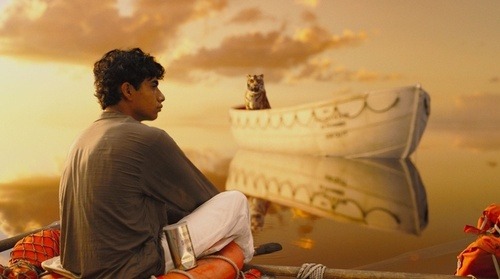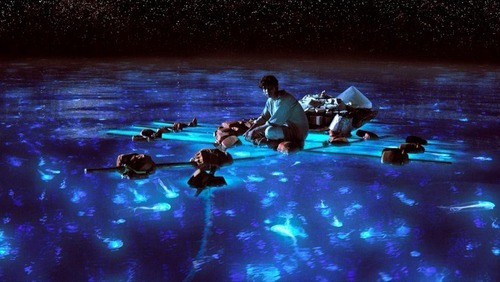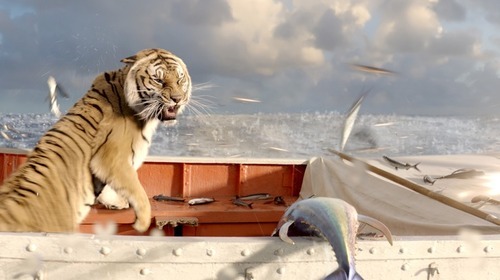
"I didn't know Hindus say amen." "Catholic Hindus do. We get to feel guilty before hundreds of Gods."
The novel Life of Pi by Yann Martel is one of the most celebrated books of the last decade. It's also passed through many hands in an attempt to adapt it into a film, among them Alfonso Cuaron & M. Night Shyamalan. Thankfully, it fell to Ang Lee, no stranger to "unadaptable" books himself having worked similar magic with Crouching Tiger, Hidden Dragon & The Ice Storm. So how did his adaptation of another "unfilmable" novel fare? Read on to find out...


The film uses a framing device not present in the novel, which worked brilliantly at first. Adult Pi (Irrfan Khan) is relating his life story to a novelist (Rafe Spall) who has encountered a bad spell of writer's block. Having met Pi's uncle, the novelist is connected with the man, who has a story to tell that will make anyone who hears it believe in God. Pi's family ran a zoo in Pondicherry, India, but circumstances have forced the family to leave the country and sell the animals to various buyers in North America.
En route to Canada, however, the cargo ship carrying the family & their animals capsizes in a storm, stranding Pi (Suraj Sharma) on a lifeboat with an injured zebra, an orangutan, a hyena, and a Bengal Tiger named Richard Parker. The tiger's carnivorous instincts soon whittle the survivors down to just him and Pi, and the two unlikely companions must fight for survival on the open Pacific Ocean.

The first thing that you'll be struck with when you see Life of Pi is how absolutely, breathtakingly gorgeous it is to look at. If you have the opportunity to see it in 3D, I highly recommend that you do, as it stands alongside Hugo & Avatar as one of the best live-action uses of the technology. The cinematography by Claudio Miranda is phenomenal, and the film's biggest asset by far. The sparseness of the open sea is used to wonderful effect for much of the film's running time, and the underwater 3D effects in particular were wondrous.
The film can get a bit tedious at times, particularly in the film's middle portions at sea. It runs just a hair over two hours, and you feel the weight of every minute once the castaways are left to fend for themselves. It's here where the film loses all the wonderful momentum it built up in the first portion of the film. It's in the final moments of the film that things really fell apart for me, however. Film is such a visual medium, and this film in particular is rife with lavish scenery, so it struck me as irritatingly odd that Lee chose to shoot a final story told in the film as nothing more than a static shot of Pi telling an alternate version of his story to two insurance adjusters that are investigating the shipwreck. It's so out of place and jarring, that it took me out of the film entirely. I suppose there were artistic reasons for doing it this way, or maybe even because of the violent nature of the story, there were concerns for securing a PG rating, but either way, it sucked all the air out of the film.
Even more unnerving, however, was the decision to have the writer & adult Pi then have a discussion where they very banally explain all of the metaphorical implications of the second version of the events. For a film that eschewed conventionality and easy answers for most of its running time, I don't know why they chose to spoon feed the audience in the home stretch. It was as if I was expecting Ang Lee to pop up in the corner of the screen and say "do you get it?"

Kudos must be given to Sharma for delivering a fantastic lead performance. For someone who had never acted in a film before, he was remarkable, conveying a range of deeply felt emotions. The film's other co-star is the, presumably, entirely CG Richard Parker. There were only maybe two moments where the rendering of this character took me out of the story, but the effects were stellar, and they made me fully believe that there was a real tiger on the boat with this boy. Khan is also very good as the adult Pi, as are Adil Hussain & Tabu as Pi's parents.
What it comes down to, for me, is that all of the goodwill the film earned in filming what certainly seemed impossible to put on film is squandered by a ham-fisted conclusion. The choice not to shoot the second version of Pi's story is mind-boggling to me, but not as much as essentially having the characters on screen spell out all of the metaphors of the story immediately after. If it weren't for the remarkable visuals and solid lead performance, it may have been enough to make me hate the film.

Life of Pi has a lot going for it, but it feels like it was a draft or two away from being a truly tight and even handed film. Whether that's the fault of Lee or his screenwriter David Magee is not for me to say, but it was sad that the film failed so horribly to stick the landing. What could have been a modern masterpiece becomes another squandered opportunity to do a book true justice on screen. When a film fails so basically in its final minutes to give you a sense of why it's a film in the first place, it becomes borderline impossible for me to do anything but admire it for what they tried to do.
I think it's worth your time for the visuals, the wonderful use of 3D, the fantastic score by Mychael Danna, and many other technical reasons. Just don't be surprised if it leaves you feeling as if you've been pandered to, because you have.
GO Rating: 2.5/5

[Photos via BoxOfficeMojo]
No comments:
Post a Comment